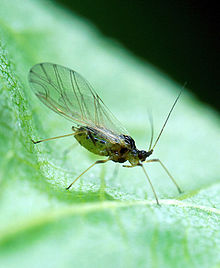- Myzus persicae
-
Myzus persicae 
Scientific classification Kingdom: Animalia Phylum: Arthropoda Class: Insecta Order: Hemiptera Family: Aphididae Genus: Myzus Species: M. persicae Binomial name Myzus persicae
(Sulzer, 1776) [1] Green peach aphid that has been killed by the fungus Pandora neoaphidis (Zygomycota: Entomophthorales) Scale bar = 0.3 mm.
Green peach aphid that has been killed by the fungus Pandora neoaphidis (Zygomycota: Entomophthorales) Scale bar = 0.3 mm.
Myzus persicae, known as the green peach aphid, is a small green aphid. It is the most significant aphid pest of peach trees, causing decreased growth, shriveling of the leaves and the death of various tissues. It is also hazardous because it acts as a vector for the transport of plant viruses, such as potato virus Y and potato leafroll virus to members of the nightshade/potato family Solanaceae, and various mosaic viruses to many other food crops.[2]
The green peach aphid is found worldwide, although it is less tolerant of colder climates and overwinters through its eggs, laid in trees of the genus Prunus. The aphid is also benefited from the presence of greenhouses in these areas.[2]
Originally described by Swiss entomologist Johann Heinrich Sulzer in 1776, its specific name is derived from the Latin genitive persicae "of the peach".[3]
Adult green peach aphids appear in the summer, and are 1.8 to 2.1 mm long; the head and thorax are black, and the abdomen yellow-green with a dark patch on the back. The nymphs are at first greenish, then yellowish in colour; those that become winged females may be pinkish. Wingless adults resemble nymphs and are 1.7 to 2.0 mm long.[2]
In the warmer months, and throughout the year in warmer climates, the green peach aphid reproduces asexually (the quicker method); adults lay nymphs on a wide variety of herbaceous plant material, including many vegetable crops such as cabbage and its Brassica relatives, potato and other crops of the family solanaceae, celery, mustard, pepper, pumpkin, okra, corn, and sunflower and other flower crops. Herbaceous weeds, such as white goosefoot (Chenopodium album) and common tumble weed (Amaranthus retroflexus) in the United States, also act as hosts. An individual can reproduce twelve days after being born and there may be twenty generations over the course of a year in warmer areas. As the weather cools, aphids mate and lay their tiny (0.6 mm x 0.3 mm) oval eggs in crevices of the bark of Prunus trees.[2]
The green peach aphid is an agricultural pest across the United States and worldwide,[2] including Australia.[4] Although insecticides are used to control it,[2] it develops resistance.[5][6] Many of its natural enemies can be used as biological control agents in certain crops, such as ladybirds (Coccinellidae) in radish crops, and the wasp Diaeretiella rapae in broccoli.[2]
Among the natural enemies of the M. persicae are both predators and parasitoids, including: beetles such as the ladybirds the two-spotted ladybird (Adalia bipunctata), seven-spotted ladybird (Coccinella septempunctata) and ten-spotted ladybird (Adalia decempunctata), true bugs such as the anthocorids or pirate bugs of the genera Orius and Anthocoris; neuropterans such as green lacewings of the genera Chrysopa and Chrysoperla, hoverflies such as Syrphus, Scaeva, Episyrphus, gall midges such as Aphidolestes, aphid parasitoids such as Aphidius,[7] and parasitic wasps of the family Braconidae.[2] They are also colonised and killed by the insect pathogenic fungi of the order Entomophthorales.[2]
An international team of scientists in 2007 studied the peach aphid's genome in the hope of understanding more about its adaptability, in search of new ways of controlling it.[8]
References
- ^ "Myzus persicae". Integrated Taxonomic Information System. http://www.itis.gov/servlet/SingleRpt/SingleRpt?search_topic=TSN&search_value=200635.
- ^ a b c d e f g h i Capinera, John L. (2005, October). "Featured creatures:". University of Florida website - Department of Entomology and Nematology. University of Florida. http://entnemdept.ufl.edu/creatures/veg/aphid/green_peach_aphid.htm. Retrieved 2009-09-07.
- ^ Simpson, D.P. (1979). Cassell's Latin Dictionary (5 ed.). London: Cassell Ltd.. ISBN 0-304-52257-0.
- ^ Berlandier, Françoise. "Aphid Pest Species of Potatoes in Western Australia". Horticulture Australia Limited. http://agspsrv34.agric.wa.gov.au/Ento/aphids/aphids6.htm. Retrieved 2009-09-09.
- ^ [1]
- ^ [2]
- ^ Response of Aphidius matricariae haliday (Hym.: Aphidiidae) from mummified Myzus persicae Sulzer (Hom : Aphididae) to short term cold storage
- ^ [3]
Categories:- Aphids
- Fruit tree diseases
- Agricultural pest insects
- Animals described in 1776
Wikimedia Foundation. 2010.
